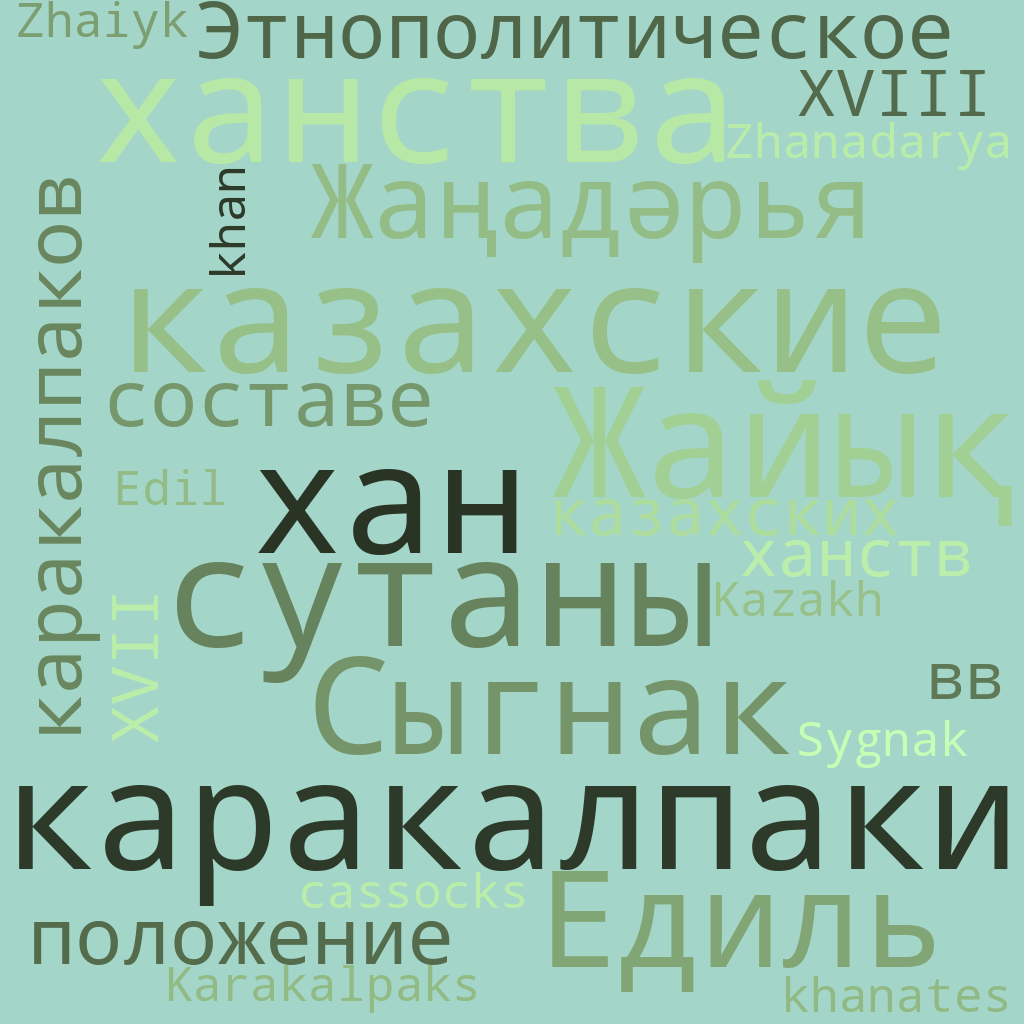Ethnopolitical position of the Karakalpaks in the Kazakh khanates in the 17th - early 18th centuries
Research Article
Keywords:
cassocks, Edil, Karakalpaks, Kazakh khanates, khan, Sygnak, Zhaiyk, ZhanadaryaAbstract
The article examines the history of the settlement and ethnopolitical life of the Karakalpak people as part of the Kazakh khanates in the 17th-18th centuries. The article provides data on the ethnic history of the Karakalpaks on the territory of modern Kazakhstan, taking into account the late period of the Ulus of Jochi through the prism of the formation of the Karakalpaks as a single ethnic group based on different proto-Turkic, late Turkic, and Mongolian tribes. Since the entire medieval history takes place in close connection with the common ancestors related to Kazakhs, the Karakalpaks were known both under another ethnic name and under their name, as historians assume. Therefore, the author of the article tried to collect and analyze materials in which the Karakalpaks are mentioned both in alliance with the Kazakhs and in opposition to them, since the Karakalpaks were part of the Kazakh khanates for almost two hundred years. Also, in the article based on European, Russian, and Eastern sources are given theoretical conclusions of leading experts are given, confirming that the bulk of Karakalpaks as a semi-independent state were part of the state of Tauke Khan and Abulkhair Khan. At the same time, a small part of Karakalpaks lived in the so-called Uzbek khanates and Aral possession. The article illustrates the dawn and crisis of relations of Karakalpaks with Kazakh khanates on the one hand, and on the other, their disintegration over the three zhuzes. Also, the article provides information about the differences in economic life from Kazakhs, cities where Karakalpaks lived and actively participated in trade relations, and played their role in the development of these cities. The reasons for the deterioration of relations with the Kazakh khanates, as sources show, were not only the levies collected from the Karakalpaks, but also active diplomatic missions with Russia, which eventually led to the final resettlement of the Karakalpaks from the Syr Darya delta first to Zhanadarya at the end of the 18th century and their further movement to the Amu Darya delta and their subordination to the Khiva khans. The article also highlights the issue of the presence of their own statehood among the Karakalpaks. Although over a long period, the Kazakh khans appointed sultans to govern the Karakalpaks, who nevertheless relied on the authority of local leaders. At the same time, these sultans pursued an independent policy and relations with neighboring peoples, which is confirmed by documents. As the study of specialized literature shows, the main materials in the study of the ethnic history of the Karakalpaks were archival documents and scientific works, which were carefully studied by leading specialists. Fundamental works were written on the basis of these materials.
Downloads
References
Andrianov B.V. Etnicheskaya territoriya karakalpakov v severnom Khorezme (XVIII-XIX vv.). In: Works of the Khorezm Archaeological and Ethnographic Expedition. Vol. III. Moscow: USSR Academy of Sciences publ. 1958. Pp. 7‒132. (in Russian)
Zhdanko T.A. Ocherki istoricheskoy etnografii karakalpakov. Rodo-plemennaya struktura i rasseleniye. In: XIX - nachale XX veka. Moskow-Leninigrad: USSR Academy of Sciences publ.1950. 179 p. (in Russian)
Ivanov P.P. Ocherk istorii karakalpakov. In: Materials on the history of the Karakalpaks. Moscow-Leningrad: USSR Academy of Sciences. 1935. Pp. 9-91.
Kamalov S.K. Karakalpaki v XVIII-XIX vv. (k istorii vzaimootnosheniy s Rossiyey i sredneaziatskimi khanstvami). Tashkent: Fan. 1968. 281 p. (in Russian)
Karakalpaki (kratkiy ocherk istorii s drevneyshikh vremen do nashikh dney). Nurmukhamedov M.K., Zhdanko T.A., Kamalov S.K. Tashkent: Fan 1971. 119 p. (in Russian)
Mambetov K. Karakˌalpakˌlar tariykhy. Ilmiy izzertleūler. Nukus: “Qaraqalpaqstan” publ. 1993. 116 p. (in Karakalpak) (in Russian)
Materialy po istorii Uzbekskoy, Tadzhikskoy i Turkmenskoy- SSR. CH. 1 (Torgovyye otnosheniya Moskovskogo gosudarstva s narodami Sredney Azii v XVI-XVII vv. Proceedings of the Historical-Archaeological Institute and the Institute of Oriental Studies of the USSR Academy of Sciences. ‒ Issue 3. Leningrad. 1932. 304 p. (in Russian)
Mezhdunarodnyye otnosheniya v Tsentral'noy Azii. XVII-XVIII vv. In: Documents and materials. Book 1. Moscow: Science. 1989. 189 p. (in Russian)
Novoletov M. Kalmyki: istoricheskiy ocherk. Sankt-Peterburg: vladel'tsa Maloderbetovskogo ulusa Noyona Tseren-Davida Tundutova publ. 1884. 77 p. (in Russian)
Pal'mov N.N. Ocherki istorii kalmytskogo naroda za vremya yego prebyvaniya v predelakh Rossii. Astrakhan': Kalmytskoye gosudarstvennoye publ. 1922. 137 p. (in Russian)
Piskunova I.V. Syrdar'inskiye karakalpaki i Rossiya v XVIII veke. Dissertation for the degree of Candidate of Historical sciences. Nukus. 1992. 144 p. (in Russian) (in Russian)
Pishulina K.A. Prisyrdar'inskiye goroda i ikh znacheniye v istorii kazakhskikh khanstv v XV-XVIII vv. Kazakhstan v XV-XVIII vv. In: Kazakhstan in the 15th–18th centuries (Problems of socio-political history). Collection of articles. Editor-in-chief Doctor of Historical Sciences B.S. Suleimenov. Alma-Ata: Nauka publ. 1969. 47 p. (in Russian)
Russkaya istoricheskaya biblioteka, Published by the Archaeographic Commission. In: Imperial Academy of Sciences. Volume six. St. Petersburg: “V. I. Golovin’s Printing House.” 1880. 682 p. (in Russian)
Rychkov P.I. Topografiya Orenburgskoy gubernii (Sochineniye P.I. Rychkova 1762 goda). Orenburg: Imperatorskoye Russkoye Geograficheskoye Obshchestvo. 1887 (Tipografiya B. Breslina). 405 p. (in Russian)
Tleumuratov M. Istoki kul'turnykh svyazey karakalpakov s sosednimi narodami. Nukus: Karakalpakstan. 1986. 96 p. (in Russian)
Khanykov YA.V. Poyezdka iz" Orska v" Khivu i obratno v 1740-1741 godakh" Gladyshevym" i Muravinym". S.-Peterburg: «Tipografiya Ministerstva vnutrennikh del». 1851. 92 p. (in Russian)
Shalekenov U. Kazakhi nizov'yev Amudar'i: k istorii vzaimootnosheniy narodov Karakalpakstana v XVIII- XX vv. Tashkent: Fan. 1966. 336 p. (in Russian)

Downloads
Published
Issue
Section
License
Copyright (c) 2025 M. Utebaev

This work is licensed under a Creative Commons Attribution-NonCommercial-NoDerivatives 4.0 International License.


